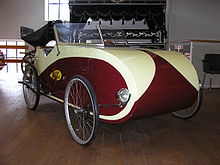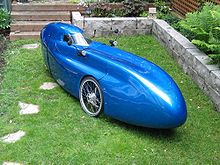Velomobile
A velomobile or bicycle car is a human-powered vehicle, enclosed for aerodynamic advantage and protection from weather and collisions.[1] They are virtually always single-passenger vehicles. They are derived from recumbent bicycles and tricycles, with the addition of a full fairing (aerodynamic shell). There are few manufacturers of velomobiles; some are homebuilt. Some models have the operator's head exposed; this has the advantage of giving the operator unobstructed vision, hearing, and some cooling, with the disadvantage of being more exposed to weather. Similar vehicles that are not human-powered are instead called microcars.
History




Before World War I Charles Mochet built a small 4 wheeled bike-car for his son. Mochet built many models of small vehicles called "Velocar". Some models had two seats, most were pedal powered but as the years went by, many were fitted with small engines.[2]
In the 1970s the PPV or People powered vehicle was produced. It was a two seat, "Sociable" tandem with a steel sub frame and molded plastic body. It was actually well designed, and relatively light, though weighing over 50 kg (100 lbs),(a recently restored version weighs 59 kg (131 lbs)) but had flaws in the execution that doomed it as a practical, every day vehicle. Positive features such as easily adjustable and comfortable seats, independent pedaling for both passenger and driver, adequate cargo space and relatively good weather protection could not overcome the negative features such as a complex, heavy and badly spaced 3 speed gear box, ineffective brakes, and pedals that slid on sleeve bearings on steel shafts which made it difficult to use as an everyday vehicle.
In Sweden a design called Fantom was sold as blueprints and became very popular, over 100,000 copies of the blueprints were sold, but few were actually completed. In the 1980s Fantomen was rediscovered by Carl-Georg Rasmussen who built a redesigned version called Leitra. The downfall of the bicycle car came when economy improved and people chose motorised transport.
All current velomobiles are produced in low volume. The only attempt at a mass-produced velomobile which was in the mid eighties flopped. This was the Sinclair C5. The C5 was a delta trike (one front, two rear wheels) with electric assist designed to be massed produced and sold for a low price. The C5 was poorly designed; it was heavy, had only one gear and had no adjustment for the distance between the pedals and the seat which is important to get a comfortable pedaling position.
Recently, some velomobiles have been converted to provide electric-assist. Electric assist means that a small battery operated electric propulsion system is provided to assist the driver's leg muscle effort. Most Electric-assist propulsion motors are of the inwheel design, such as the Heinzman electric motor or the Bionx. While an electric-assist unit does add extra weight to the velomobile, it is somewhat offset by the flexibility it also provides, especially during hill climbs.
The Leitra is currently the commercial velomobile in production for the longest period of time — since 1983. Other manufacturers include Cab-bike, Velomobiel.nl, Sinner Ligfietsen, bluevelo and Alleweder, the go-one (Germany), go-one.us and Flevobike (makers of the Versatile).
Characteristics




A practical velomobile has many competing requirements. It should have as many of the following characteristics as possible.
- Light weight
- Good visibility for the operator (clear front vision is especially important, but a 360 degree view is also desirable).
- Adjustable seating
- Maneuverability (steering, braking)
- Roll stability (steering, braking and adverse camber)
- Safety in collision and over bad roads
- Ventilation, including a windscreen defroster. This should be adjustable for more cooling in warmer weather.
- Many gears; a vehicle that is heavier but more aerodynamic than a bicycle needs a wider gearing range than a bicycle.
- Aerodynamics - which allows greater speed for a given level of effort, or reduced effort on level ground and against headwinds.
- Low rolling resistance - primarily dependent upon the tires.
- Enclosed wheels, aerospoked wheels, or wheel discs.
- Single-sided wheel mounts - to facilitate puncture repair, inner-tube and tire changes.
- Good suspension.
- Reliable operation.
- Efficient transmission.
- Low maintenance, because of the fully enclosed transmission components, such as chainwheel, chain & gears.
- Strong wheels, brakes, transmission, more so than on a lightweight bicycle.
- Efficient brakes - an unbraked velomobile with good aerodynamics can rapidly reach dangerous speeds in a descent. Caliper brakes are unsuitable, and disk brakes are rarely fitted. Drum brakes are often used, but long descents can cause overheating and so fading. Some velomobile pilots use drogue parachutes as used by runners during training. These parachutes need to be stabilised to avoid tangling and offer greatly increased on long, steep descents. It is best to use two smaller parachutes than one large, because of the sudden deceleration upon deployment. An alternative is to remove wheel fairings (if fitted) and take periodic stops to allow the brakes to cool.
- Parking brake - essential to prevent the velomobile rolling away.
- Cargo capacity suitable for everyday shopping.
- Low noise, for both the comfort of the operator and safety in traffic.
- Multiple tracks (tricycle or quadracycle design) for safety and practicality in slippery weather.
- Easy entry and exit.
- Strong headlights to identify obstacles and hazards at the high speeds
- Visibility to others. Velomobiles are unusual and much lower than conventional cycles. Also, velomobiles do not show pedaling movements and other visual clues to other road users. An inattentive driver may mistake a fast-moving velomobile for a car at a much greater distance (totalled Quest velomobile).
- Front, side and rear running lights, preferably strobe lights, even in daylight. A nose strobe with enhanced sideways emission to attract the attention of other road users when emerging into traffic from behind an obstacle ("creep and peep" technique). Because the pilot's head is positioned to the rear, which hinders the usual observations.
- Fluorescent colours; retroreflective decals and tyres with reflective side-walls.
- Two warning devices: a pedestrian-friendly bicycle bell and a very loud horn for motor vehicles, aggressive dogs and inattentive pedestrians with personal stereos or cell phones on cycle paths.
- Optional Safety flag for visibility in traffic. The flag increases drag, but announces the presence of the velomobile to drivers who cannot see it directly. It is best if the flag is mounted close to the front of the velomobile, to enhance visibility when emerging from a side-road.
- Very easy to ride.
- Low price (from around 5,000 to 10,000 USD) - currently hindered by the low-volume of sales and manufacture.
DIY velomobiles
With a growing DIY-community and an increasing interest in environmentally friendly "green energy", some hobbyists have endeavored to build their own velomobiles from kits, sourced components, or from scratch. [4] When compared to similar sized commercial velomobiles, the DIY velomobiles tend to be cheaper. [5]
See also
References
- ^ Frederik Van De Walle. The Velomobile as a Vehicle for more Sustainable Transportation ISSN 1651-0194, Retrieved on 2007-11-23.
- ^ The Real History of the Recumbent Bicycle Retrieved on 2008-03-26.
- ^ Sherwood Stranieri (2008-03-11). "An Awfully Tempting Velomobile". Using Bicycles. Retrieved 2008-04-26.
- ^ Building a velomobile DIY, description with usable designs
- ^ DIY velomobiles cheaper than commercial ones
External links
- Velomobiling.com
- The North American Velomobilist Website
- bluevelo velomobile website
- Leitra velomobile website
- Velomobiel.nl - manufacturer of the Quest Velomobile
- Sinner - manufacturer of the Mango Velomobile
- Velomobile Comparison Tables
- Open Source Velomobile Development Project from the IHPVA
- Building a velomobile DIY, description with usable designs
- KV4 (Alleweder) velomobile kit. The aluminium KV4 is an updated version of the proven Alleweder design. Download the KV4 velobile construction manual. Not available in the US. However, the similar ready-built Flevobike Alleweder (FAW+)is available in the US. Kits are available for importation into in the US.
